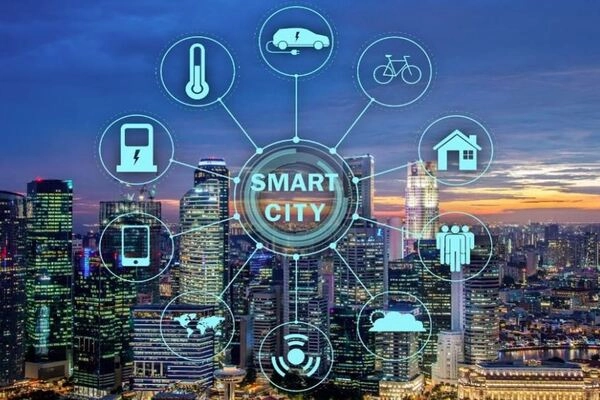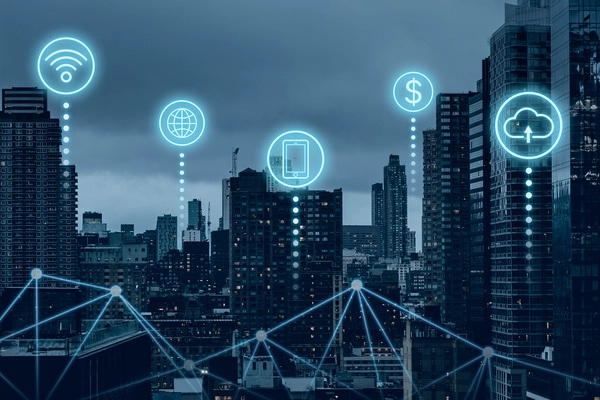In the era of digital transformation and rapidly advancing technology, developing an IoT smart city (Smart City IoT) has become a crucial strategy for helping urban areas optimize infrastructure management, enhance public services, and improve residents’ quality of life. From monitoring traffic, environment, and energy systems to managing waste, IoT solutions play a key role in operating a smart, efficient, and sustainable city. This article explores in depth the concept, applications, implementation requirements, key technologies, and future prospects of Smart City IoT in Vietnam.
What is an IoT Smart City (Smart City IoT)?
An IoT smart city is an urban model that integrates sensor devices, Internet connectivity systems, and big data to manage, operate, and deliver public services intelligently. Smart City IoT aims to enhance urban management efficiency, conserve resources, reduce operational costs, and provide residents with a convenient and safe living experience.

This concept is not limited to applying technology to physical infrastructure; it also encompasses the management of traffic, energy, water, waste, the environment, public security, healthcare, and education. With Smart City IoT, data collected from sensors and connected devices is analyzed and used to predict needs, support intelligent decision-making, and automate various processes.
Implementing an IoT smart city helps urban areas operate more efficiently while promoting sustainable development, reducing pollution, saving energy, and improving overall quality of life. In the following sections, we will explore the practical applications of IoT in modern smart cities.
Applications of IoT in Smart Cities
The application of IoT in smart cities not only enhances operational efficiency for authorities but also improves the experience of residents. By connecting devices and gathering real-time data for analysis, IoT enables quicker and more accurate decision-making. Below are some typical applications:
Traffic management and congestion reduction
Traffic congestion remains one of the biggest challenges in modern urban areas. With IoT smart city systems, sensors, cameras, and vehicle tracking devices continuously collect and analyze data. The system can automatically adjust traffic light signals, forecast congestion, issue accident alerts, and suggest alternative routes.

In addition, mobile applications allow residents to access real-time traffic updates and choose the most efficient routes, helping reduce congestion and minimize pollution caused by vehicles idling for long periods.
Efficient Water and Waste Management
Managing clean water, wastewater, and solid waste is one of the key components of Smart City IoT. Sensors that monitor water levels, pressure, and quality help detect leaks, contamination, and abnormal loss.
Smart waste collection systems equipped with fill-level sensors optimize collection schedules, reduce operational costs, and improve recycling efficiency. As a result, cities become cleaner, more cost-effective to manage, and less harmful to the environment.
Environmental and Air Quality Monitoring
Environmental pollution and air quality directly impact public health. IoT sensors can measure fine dust (PM2.5), CO2, NOx, and other pollutants, transmitting real-time data to urban management centers.
Based on this data, authorities can issue public warnings, adjust traffic activity, plan tree-planting initiatives, and implement pollution-reduction measures. This demonstrates how IoT smart cities help protect the environment and improve community health.
Smart Energy and Lighting Systems
Energy efficiency is one of the core goals of Smart City IoT. Smart streetlights, intelligent substations, and energy management systems enable cities to monitor, control, and optimize electricity consumption.

For example, streetlights can automatically adjust their brightness in real time, using sensors to detect pedestrians and provide illumination only when needed. Combined with AI, the system can predict energy demand by hour, day, and season, allowing electricity to be distributed efficiently, minimizing waste, and ensuring energy security.
Conditions for Implementing Smart City IoT
The implementation of an IoT-powered smart city depends not only on technology but also on various factors related to infrastructure, policy, resources, and collaboration among stakeholders.
Strong Digital Infrastructure
Digital infrastructure forms the foundation of Smart City IoT. This includes high-speed Internet networks, data transmission stations, sensors, cameras, data processing centers, and cloud storage systems. A robust infrastructure enables seamless connectivity between IoT devices, ensuring fast, secure, and stable data transmission.
Supportive Policies and Regulations
Policies and regulations on privacy, data security, IoT standards, and open data management play a critical role in the successful deployment of Smart City IoT. Governments and local authorities need to establish a favorable legal framework that encourages businesses, researchers, and other stakeholders to participate in developing smart urban solutions.
Investment Resources and High-Quality Human Capital
Building an IoT smart city requires significant financial investment and a workforce of experts in information technology, AI, big data, and urban management. Training, attracting, and retaining high-quality talent are essential conditions for operating and sustaining Smart City IoT.
Collaboration Among Stakeholders
Smart City IoT is a multidisciplinary initiative that cannot be carried out by a single organization. Collaboration among government agencies, technology companies, universities, research institutes, and local communities helps create integrated solutions that address real needs and support sustainable urban development.

Key Technologies in IoT Smart Cities
Technology is the driving force behind the development of IoT-powered smart cities. These innovations not only enable data collection and analysis but also strengthen security and improve urban management efficiency.
IoT, AI, and Big Data
IoT generates massive amounts of data from connected devices throughout the city. AI analyzes this data to predict demand, optimize operations, and automate various processes. Big Data handles large-scale datasets, enabling accurate decision-making, trend forecasting, and improved delivery of public services.
5G Networks and Cloud Computing
5G provides high-speed data transmission, low latency, and the ability to connect a vast number of IoT devices simultaneously. Combined with cloud computing, data from sensors and smart devices can be processed quickly, stored securely, and delivered in real time.
Blockchain and Cybersecurity
Blockchain enhances data security, prevents tampering, and increases transparency for digital transactions within smart cities. Cybersecurity solutions protect IoT systems from attacks, ensuring continuous, safe, and reliable data operations.

The Future of IoT Smart Cities in Vietnam
Vietnam is actively developing smart cities in Hanoi, Ho Chi Minh City, Da Nang, and many other urban areas. The adoption of IoT-based smart city solutions will enhance the management of transportation, environment, energy, waste, and public services. At the same time, IoT technologies will help improve quality of life, reduce costs, and promote sustainable development.

Although challenges remain in terms of infrastructure, resources, and policy, Vietnam—with support from modern technologies, international cooperation, and well-planned investments—has the potential to become a pioneer in implementing IoT-based smart cities in Southeast Asia. This development creates opportunities to attract investment, foster innovation, and enhance the competitiveness of Vietnamese cities on the global technology landscape.
IoT smart cities represent an inevitable trend for modern urban areas, enabling more efficient infrastructure and public service management, environmental protection, energy savings, and improved quality of life. With a strategic vision, Vietnam is fully capable of becoming a model for IoT-driven smart urban development, ushering in a true smart city era for both citizens and businesses.
